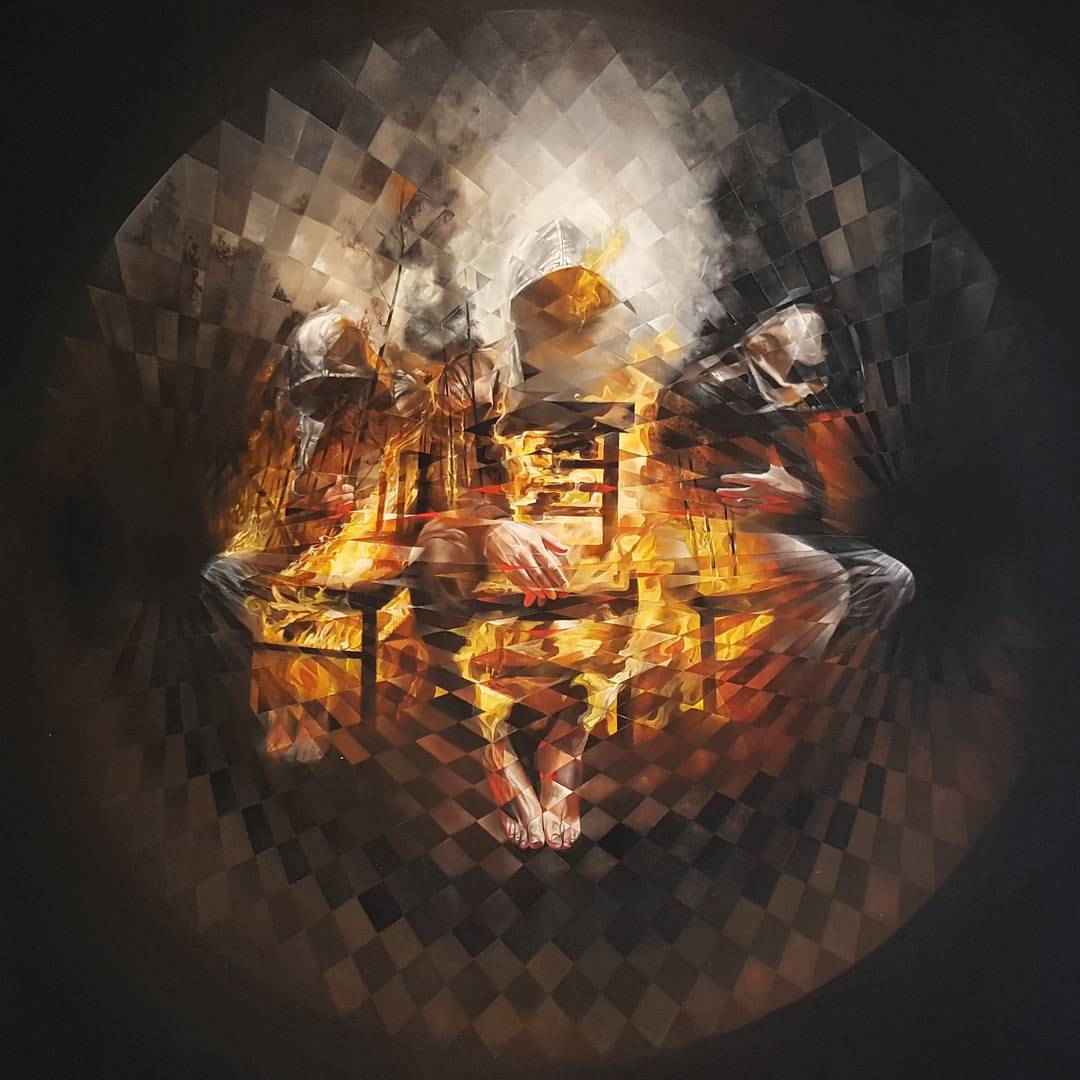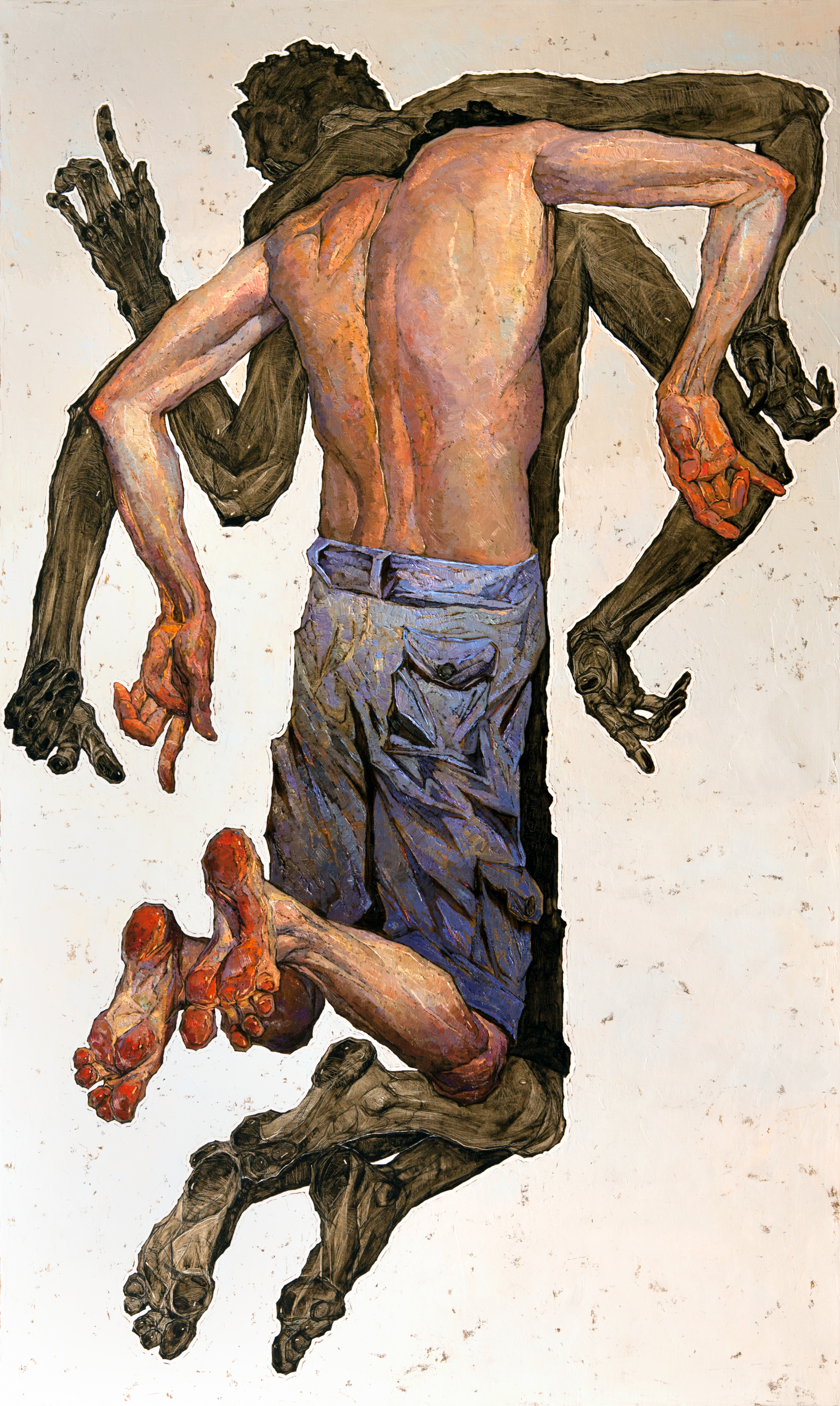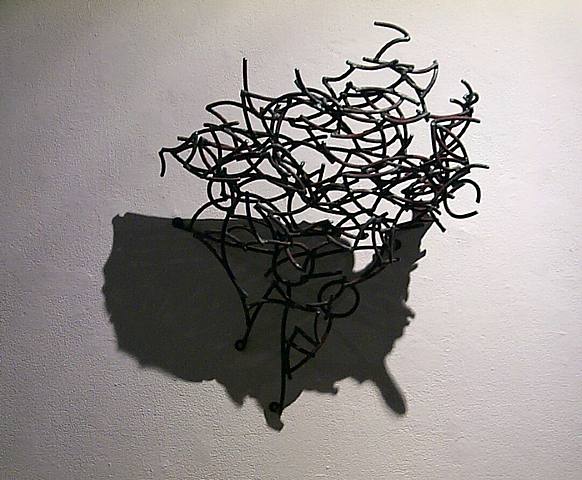Love Trump or hate him, either way you’re thinking about him.
It’s almost impossible to underestimate the influence of Donald Trump. Misguided as they may be, we scrutinize his beliefs and behavior more closely than just about anything else in modern society. If he posts a 100-character tweet, it’s only a matter of seconds before a legion of wild-eyed bloggers frantically starts clacking away at 100,000 word analyses, desperate to beat each other to the scoop.
Don’t feel bad about it. You’re not alone. Everybody is thinking about Trump these days: lawyers, politicians, immigrants, journalists, doctors, the alt- right, the alt- left, activists, Democrats, Republicans, Libertarians, Bernie Bros, anarchists, vacuum cleaner salesmen, SOVO// writers, and of course, artists.
His presidential omnipresence was never more salient than at the most recent installment of the LA Art Show. This annual event, which is America’s longest-running art show, spotlights a wide variety of local and international artists. Thousands of people stormed the Downtown Los Angeles Convention Center to witness the visual spectacular, which was rumored to be bigger, better, and more interactive than ever before.
For those readers who aren’t also journalists that cover art shows (so…pretty much all of you), condensing the infinite stimulation of an art show into a digestible piece of writing is no easy feat. Visual art is generally created to be as eye-catching as possible, with the best art effortlessly capturing your attention. That’s fine and dandy when you’re viewing art in a controlled context. But in the midst of a crowded show featuring numerous pieces from 128 galleries, overstimulation becomes a serious problem.
It’s a bit like leaving a six-year old unattended in a candy shop. She might go wild and scarf down as much candy as she can get her little hands on. She might focus on one kind of candy, or methodically work her way through the store. She might even become paralyzed by the multitude of choices, ultimately doing nothing at all. What she’s certainly not going to do is walk out of that candy shop with a coherent essay describing her experiences in nuanced detail.
As a journalist in chaotic situations, it’s imperative to ignore the noise. Listen for the signal. Look for themes. Find the best piece of candy. Recognize when patterns repeat in unexpected ways. Ask about the elephant in the room. Follow the crowds, follow the money, follow the stink. That’s where the story is.
So where was the story at the LA Art Show? Just where it always seems to be these days: in the shadow of Donald Trump.
—
Art isn’t created in a vacuum, but instead is a reflection of the circumstances surrounding its creation. For many artists, adding a personal spin on a piece of art builds the foundations of their artistic style. It distinguishes them from other creators.
Most often, this spin is defined by the artist’s life experiences, standing in society, and the greater socio-political climate they live. When you consider the President’s ubiquity in nearly every facet of modern society, it’s hardly surprising that Trump colored the personal spins of numerous artists featured in the LA Art Show.
Yes, there was the usual slew of clumsy political art you’ve come to expect from any art show, but what really stuck us was how often politics seemed to influence art which might have been deemed apolitical in a different era.
Being a left-leaning show in California, most of the art we saw exhibited disdain for the antics of Trump and his cronies. They drew on the sense of resistance that runs rampant among those of us who lean left, and seemed to rally against both the ideology of Trump’s supporters and the man himself.
Scorn for Trumpology manifested itself in a number of ways at the LA Art Show. Some artists used dashing splashes of color against otherwise whitewashed backdrops, making subtle statements about the lack of diversity among America’s most powerful circles. Others asked their audiences to interact directly with their art — a refreshing experience for a group of people used to operating under the hyperpolarized, us-vs-them mentalities that dominate today’s popular thought.
Below are a handful of our favorite examples of apolitical art that makes statements about Trump’s administration from this year’s LA Art Show. In some of these pieces, the artist injected their political beliefs into the art, intentionally or otherwise. Others are likely cases of us projecting our political beliefs onto these pieces. In a sense, it doesn’t matter. The ability to extract different truths from a single work of art is one of the criteria that defines a masterpiece.
Stranger, 2014 / Han Young Wook
Created in 2014, this installment of Han Young Wook’s Stranger series depicts a crowd of everyday citizens, lost in their own worlds. Considering the timeframe when the artist created this piece (which utilizes oil paint on scratched aluminum), it’s unlikely that Wook was inspired explicitly about the Trump administration.
That said, this phenomenal piece oozes prescience. In the foreground are a handful of figures in grayscale — note the racial and gender identities of the most prominent characters. It’s only as your eyes move up and away from the monochromatic men that you start to see the color, vibrancy, and diversity of the crowd as a whole.
When many people think of an “average American,” they probably imagine someone who looks strikingly like one of the two figures in the foreground of this image. This is a false reality but a very pervasive one. It’s often difficult to recognize that the real beauty of America can only be seen when you consider the diversity of the crowd as a whole.
Trump didn’t create this paradigm, but he’s benefitted from it dramatically. When he insists that we make America great again, what he’s really saying is that we should generally focus on only those first few monotone faces in the foreground. He completely misses the background in all its technicolor glory.
Super Massive Black Hole, 2016 / Vesod Brero
In addition to color, artists also make statements by using composition. This piece, SMBH by Italian artist Vesod Brero, is defined by the interplay of the hooded figures, the fire and a warped checkerboard pattern. At first glance, the piece is difficult to comprehend but leaves you feeling unsettled nonetheless (a metaphor which practically speaks for itself).
Look again, however, and you’ll notice a number of elements that might exemplify socio-political tensions. For example, the hooded figures aren’t sitting behind the inferno, nor in front of it. They’re right in the middle, and what’s more, they seem pretty calm about the entire situation. It’s almost as if they were the masterminds behind the fire, intentionally stoking the flames to clean the slate of the old guard in preparation for a new regimen.
In Trump-speak, we might call such an action “draining the swamp” or “fake news,” but the underlying strategy is the same — burn down the old to make way for the new. What other reason would Trump have for continually disparaging institutions like mainstream media, law enforcement agencies, or even the concept of facts in general?
Some men just want to watch the world burn, and others just want to build from the ashes. Trump generally falls in the latter category, but he must first burn if he wants room to build.
We won’t extrapolate too much more on SMBH, but it is worth noting one last thing: the hoods of the figures obscure their personal identities, but their racial identities are full display. Just look at the hands.
Pantomime No. 9, 2017 / Denis Sarazhin
Trump’s relationship with the truth could be described as tenuous at best. To phrase that more pointedly, Donald Trump is a liar. He lies even when he can be objectively disproved; indeed, he lies more often when he knows he can be objectively refuted by a mainstream media outlet. The very fact that his lies can be disproved only makes them stronger. When someone calls his bluff, it only makes his oft-repeated claim that the media is out to get him that much more believable.
In response, the media has been forced to polarize itself. Some outlets have taken to portraying Trump as a demon, hell-bent on ripping apart the fabric of American society. Others claim he’s our savior, the liberator who will bring our country to new heights.
How often is Trump characterized as a flawed figure with a few good ideas and a few bad ones? There is no place for moderation in the Trump era.
The piece above, Pantomime No. 9 by Ukrainian artist Denis Sarazhin, poignantly illustrates this concept. In the foreground sits a realistically-colored figure. He looks strong, confident, and white. One might liken this figure to the image of Trump perpetuated by platforms like Fox News or Breitbart. He’s a champion of the common man, strong and capable of wrestling with the darker parts of society on our behalf.
But behind the realistic subject lurks a murky mess of doppelgangers, nearly overtaking the main character. They share a general form with humans, but these shadowy figures are clearly something else; the gloomy colors, the excess of limbs, and the body proportions just aren’t quite right. These figures might symbolize the story of Trump peddled by left-leaning media outlets like CNN or the Huffington Post. These organizations tend to characterize Trump as a nebulous, ominous figure, perhaps even sub-human.
Neither the main figure nor the shadows reveal their face and confirm their true identity. This act of concealment is the real nugget of truth in Pantomime No. 9. It doesn’t matter whether you buy into Trump’s hero facade or consider him a real-life Disney villain — neither are his true form. Neither shows his real face. Neither paints a realistic picture of the man.
America, / Larry Kagan
We’ll leave you with this piece, fittingly titled America by Larry Kagan, which offers a more positive depiction of modern America. It shows us that while not everything is how it seems to be, that’s not necessarily a bad thing. Sometimes, the hidden version is even better than what you’ll find at surface level.
In America, the twisted and chaotic lumps of metal are much like the American people. We’re confused, tired, and difficult to understand. It’s tough to know where to begin with us. We’re polarized, yet inextricably jumbled together. To an outside observer, we can look like a mess without a coherent identity.
But when we’re put under the right light, everything clicks into focus. We become the nation we were always meant to be — strong, tolerant, and beautiful. We become cognizant that every piece is necessary to complete the image, no matter its race or wealth or political beliefs. As our name suggests, we stand united.
We haven’t lost our understanding of this truth in the age of Trump, but we’ve done a poor job of practicing it. If this year’s LA Art Show taught us anything, it was a simple reminder of this fact: every piece matters.
— Written by Jack Smith
“Deals are my art form. Other people paint beautifully on canvas or write wonderful poetry. I like making deals, probably big deals. That’s how I get my kicks.” — Donald Trump



